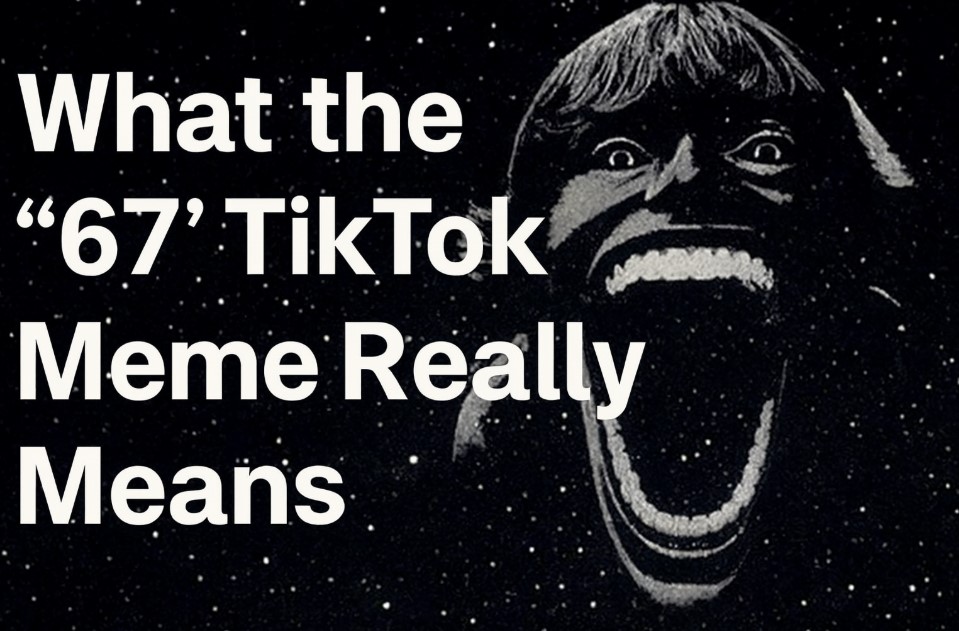Social Media
What the “67” TikTok Meme Really Means

The internet has once again turned a random sound into a viral sensation. The “67” meme, often pronounced “six-seven,” has taken over TikTok, YouTube Shorts, and even classrooms worldwide. Kids are repeating the number, adding hand gestures, and laughing at what seems to be an inside joke. Adults are left wondering what it means and where it came from. To understand why this meme has become such a cultural phenomenon, it is helpful to examine its origins, rise, and how it reflects the humor of a new generation.
Where the “67” Meme Came From
The “67” meme originated from a song called Doot Doot by rapper Skrilla. In the track, Skrilla repeats the lyric “six-seven” in a catchy rhythm. The soundbite gained traction on TikTok when users began clipping and using it out of context. What started as a simple piece of audio quickly became one of the most recognizable and repeated memes on the platform.
A major turning point came when a viral TikTok showed a child at a basketball game shouting “6-7!” into the camera right before a player made a shot. The video spread rapidly, and the child’s enthusiastic delivery became iconic. That moment linked the sound with an expressive, almost chaotic kind of energy. From there, users began remixing and editing the video, sometimes transforming the child into surreal or distorted versions to exaggerate the meme’s weirdness.
The meme also became associated with Charlotte Hornets player LaMelo Ball, who happens to stand 6 feet 7 inches tall. A TikTok edit combining Skrilla’s song with commentary about LaMelo’s height helped connect the number “67” to the basketball world. Since then, creators have used it for jokes, reactions, and parodies that extend far beyond sports.
What “67” Actually Means
Despite how widespread it is, the “67” meme doesn’t have a concrete meaning. And that’s exactly the point. Many TikTok trends work because of their randomness. In this case, “67” became a phrase that’s funny to say, even if it doesn’t mean anything at all.
Some people suggest that it’s a stand-in for describing something average or “mid,” like saying something is a “six or seven out of ten.” Others believe it’s just a meaningless number that caught on because it sounds fun to repeat. TikTok creator Philip Lindsay, who analyzed the meme in one of his videos, explained it best: “There is no real meaning to it. It’s just a number that is fun to say, popularized by a meme with hand motions, and it doesn’t mean anything.”
Because the meme has no set definition, it allows users to adapt it to almost any context. For example:
- Some students say it randomly in class to get a laugh.
- Creators use it in captions or reactions to confusing moments.
- Memes pair “67” with exaggerated edits, filters, or motion effects.
The flexibility of the number gives it universal appeal—it can mean whatever the creator wants it to mean.
How it Become a Viral Trend
TikTok trends often follow a pattern: a catchy sound, a simple action, and mass participation. “67” fits this pattern perfectly. Several factors helped push it to viral status:
- A memorable sound: The repetition of “six-seven” in Skrilla’s track is rhythmic and easy to mimic.
- Visual simplicity: The hand motion often used with the sound makes it easy to copy.
- Accessibility: Anyone can join in without special skills or equipment.
- Algorithmic push: As more people commented or used the sound, TikTok’s algorithm boosted its visibility.
- School culture: Students repeating “6-7” in classrooms helped spread it offline, reinforcing the online loop.
The randomness itself became the humor. When teachers and parents tried to make sense of it, that confusion only made the meme funnier for those in on the joke.
The Role of LaMelo Ball and Pop Culture
As the meme grew, basketball fans connected it to LaMelo Ball’s height of 6’7”. A viral TikTok mashup featuring Skrilla’s “six-seven” lyric and a sports announcer describing LaMelo’s movements made the connection stronger. Soon, fans began associating the number with him, especially in basketball-related memes.
This crossover between internet humor and pop culture is typical of modern TikTok trends. Real-world figures, sports commentary, and music often blend into memes, giving them more depth and variety. It also shows how fast a simple online joke can spill over into public spaces and live events.
Why Gen Alpha Finds It Funny
The “67” meme is part of a larger trend in Gen Alpha humor—absurdism. Unlike earlier generations that preferred structured punchlines, Gen Alpha often finds humor in chaos, confusion, and inside jokes that don’t make sense to outsiders. Memes like “Italian Brainrot” or random distorted edits share the same DNA as “67.” The joke isn’t about meaning; it’s about being part of something that feels exclusive and unpredictable.
This kind of humor is shaped by the digital environment Gen Alpha grew up in. With endless scrolling, remixing, and fast meme cycles, randomness feels normal. “67” represents that digital culture perfectly: simple, funny, and ever-evolving.
How Long Will “67” Last?
Like most viral memes, the “67” trend will eventually fade as new jokes replace it. Once adults, media outlets, and explainer articles begin discussing it, the mystery fades and the humor shifts elsewhere. But even when it dies down, it will likely remain a recognizable piece of TikTok history, remembered the same way people recall “Skibidi Toilet” or “Ohio memes.”
Its legacy lies not in meaning but in how it shows TikTok’s ability to turn random fragments of audio into massive global trends. “67” is proof that sometimes, all it takes for something to go viral is a catchy sound and a sense of shared absurdity.
Final Thoughts
The “67” TikTok meme doesn’t have a deep meaning or secret message. It’s a number that became funny because of repetition, timing, and the joy of confusion. From Skrilla’s song Doot Doot to basketball references and distorted edits, “67” evolved into a cultural shorthand for TikTok’s playful and unpredictable nature.
For many, it’s a reminder that not every trend needs an explanation. Sometimes, the best part of internet culture is simply being in on the joke—laughing at something that doesn’t have to make sense. “67” is a perfect example of how randomness can unite millions online, even if no one can fully explain why it’s funny.
-

 Tech2 months ago
Tech2 months agoSora 2 Invite Code: How to Get One (Step-by-Step Guide)
-

 Business2 months ago
Business2 months agoDubai Freezone Company Formation: From Name Reservation to Bank Account
-

 Tech2 months ago
Tech2 months agoWhat To Do When Your Business Faces Network Vulnerabilities
-

 Auto2 months ago
Auto2 months agoHow to Compare Car Insurance Plans for Maximum Savings






